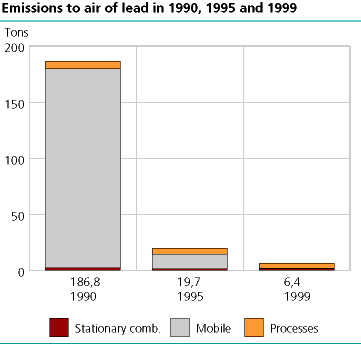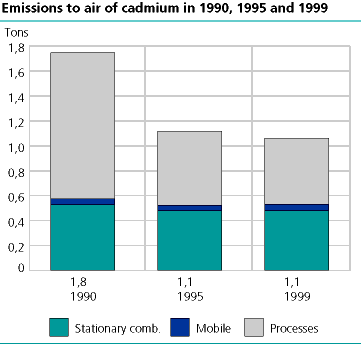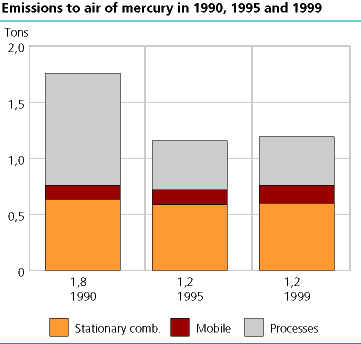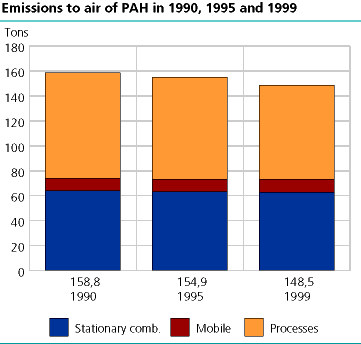Content
Published:
This is an archived release.
Emissions of hazardous substances higher than previously estimated
Emissions to air of the major heavy metals (lead, cadmium and mercury) and PAH (Polycyclic Aromatic Hydrocarbons) fell over the course of the 1990s. The level of emissions today is, however, higher than previously estimated, according to new statistics from Statistics Norway and the Norwegian Pollution Control Authority.
Through the Convention on Long-Range Transboundary Air Pollution, Norway is committed to reducing emissions to air of selected environmental hazardous substances from the 1990 level. The Governments goal, set in 1997, is to reduce total emissions substantially by 2010. The decision has been made to use 1995 as the basis year for evaluations of this goal. The statistics show that emissions have largely been reduced, but the reductions are somewhat smaller than earlier calculations have shown. In the last year, the Norwegian Pollution Control Authority has checked the quality of the emission data reported from large industrial plants. This work has not only resulted in the registration of emissions from more sources, but also that emission figures from individual plants are higher that earlier reports have shown. At the same time the methods for calculating emissions from smaller individual sources have improved. Recalculations of earlier estimates were therefore performed so that emission figures for 1990-1999 are comparable. Emissions of mercury and PAH are included for the first time in the emission statistics Statistics Norway compiles in cooperation with the Norwegian Pollution Control Authority.
Lead
Emissions from the manufacturing industry are the main source of lead emissions to air in Norway today. In 1999 these accounted for two-thirds of total emissions. Before 1996, emissions from the use of leaded gasoline was the main source. Emissions of lead have been reduced by 97 per cent since 1990 as the result of the phasing out of leaded gasoline. Emissions from manufacturing have been reduced by 40 per cent, mainly as a result of the closure of manufacturing plants with high emissions. Total emissions have been cut by nearly 70 per cent since 1995. The current level (1998) of emissions of lead from the manufacturing industry is more than twice as high as previously published. This is because of better and more complete reporting of emission data from companies.
Cadmium
Emissions to air have been reduced by 39 per cent since 1990 and by 5 per cent since 1995. The largest proportion of the emissions is due to production of metals, particularly ferroalloys. The decline in emissions may be explained by a decline in emissions from the production of zinc. Production of zinc was the major source of emissions of cadmium in the early 1990s. The current level (1998) of emissions of cadmium from the processing industry is about twice as high as previously published. This because of better and more complete reporting of emission data from companies.
Mercury
Emissions have been reduced by 32 per cent since 1990, but have increased somewhat since 1995. The main sources of emissions of mercury today are the production of ferroalloys and burning of wood and wood waste. In the early 1990s the use of products containing mercury was a major factor (e.g. mercury thermometers). The decline in emissions can mainly be explained by lower emissions from the production of ferroalloys but also that emissions from the use of products have been substantially reduced.
PAH
Emissions to air of PAH (Polycyclic Aromatic Hydrocarbons) in Norway are mostly due to combustion of fuel wood, production of aluminium and transport. Emissions (calculated in accordance with Norwegian Standard 9815 developed for the aluminium industry) have been reduced by 6 per cent since 1990 and 4 per cent since 1995. There has been a decline in emissions from road traffic, despite increased traffic, as a result of tighter emission standards for particulate matter and VOC (Volatile Organic Compounds). Straw burning declined in the 1990s, leading to a decline in these emissions, although the figures are uncertain here. Emissions from fuel wood combustion have increased. Increased use of modern wood stoves will cause these emissions to drop in the future. Emissions from the production of aluminium have been relatively stable despite an increase in production, because of changes in the manufacturing process.
Statistics on emissions to air of environmental hazardous substances have a high degree of uncertainty and can be incomplete, and the published figures can therefore change in the event of new knowledge. Uncertainty is generally higher for 1990 than for 1999.
New figures have also been published for emissions of greenhouse gases, NOX, SO2, NH3, NMVOC, CO, and particulate matter. Click here to see tables and figures.
The statistics is published with Emissions to air.
Contact
-
Statistics Norway's Information Centre
E-mail: informasjon@ssb.no
tel.: (+47) 21 09 46 42




